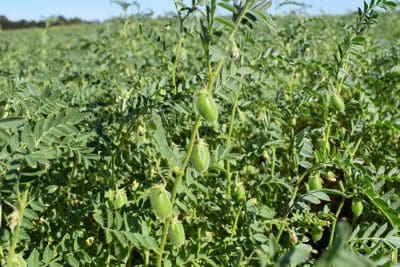AUSTRALIAN scientists are at the forefront of an exciting project isolating the genes from wild chickpea plants from Turkey to develop new lines of chickpeas with resistance to the damaging disease, Ascochyta blight.
 Accessing new sources of wild chickpeas from the Fertile Crescent in the Middle East where the chickpea plant originated, researchers are working to identify the small percentage of those plants that have natural resistance to Ascochyta, and pinpoint the genes that give them that resistance.
Accessing new sources of wild chickpeas from the Fertile Crescent in the Middle East where the chickpea plant originated, researchers are working to identify the small percentage of those plants that have natural resistance to Ascochyta, and pinpoint the genes that give them that resistance.
The work has reached the stage where they are now confident they will be able to provide plant breeders with Ascochyta-resistant material within the next three to five years.
Centre for Crop and Disease Management program leader, Dr Lars Kamphuis, Perth, WA, said before having access to the wild chickpea germplasm, researchers had been screening for Ascochyta resistance in the lines of modern-day, domesticated chickpeas currently available.
“From their screenings they found the majority of the germplasm is highly susceptible to Ascochyta. There was little germplasm they identified that performed better than the varieties that are being grown, like PBA HatTrick or Genesis,” he said.
“So, through the efforts of colleagues at the University of California Davis and CSIRO, they brought back wild germplasm from south eastern Turkey, the origin of chickpeas.
“That significantly expanded what was a very small germplasm collection to now close to 1000 individuals across the wild species. That offers tremendous opportunity to start looking for adaptive traits in that material that we require in Australia.”
Speaking at the Northern Crop Protection Forum at Dalby in southern Queensland, Dr Kamphuis said researchers had so far identified 150 lines from the wild germplasm that had resistance to Ascochyta.
“As more of the wild material comes in, we will continue to screen it. But the material we have already identified with some resistance, we have started to cross it to PBA HatTrick and Kyabra. We have grown those populations in the field this year and will be harvesting the seeds from them,” he said.
Dr Kamphuis said the next step would be to phenotype those populations and correlate the phenotype with the location in the genome that conferred the resistance.
“What that allows us to do is develop molecular markers that flag in the genome where we know the resistance lies,” he said.
“We can provide that, along with a line that is PBA HatTrick-like but also has resistance, to PBA Australia and other chickpea breeding programs so they can quickly follow it with this marker.
“They don’t have to do the phenotyping and grow the plants for several weeks before doing the inoculations. They can do a quick assay in the lab to identify which lines have it and which don’t and quickly introgress the resistance.
“Hopefully in the next three to five years we will be able to provide breeding programs with germplasm that has good resistance to Ascochyta which will lead to the release of more elite varieties in years to come.”
Dr Kamphuis said the approach researchers were taking with the Ascochyta resistance project in chickpeas was similar to what partner organisations were doing in developing resistance in other crops to nematodes, phytophthora and environmental stresses, such as drought, cold and high temperatures.


HAVE YOUR SAY